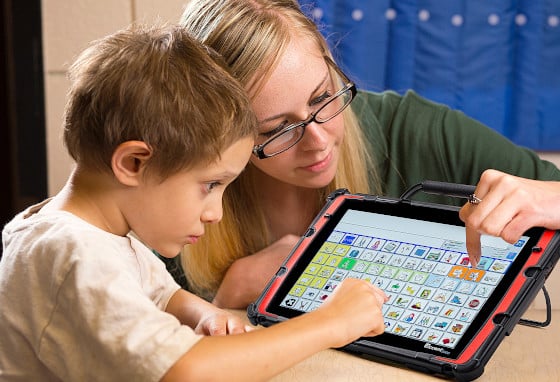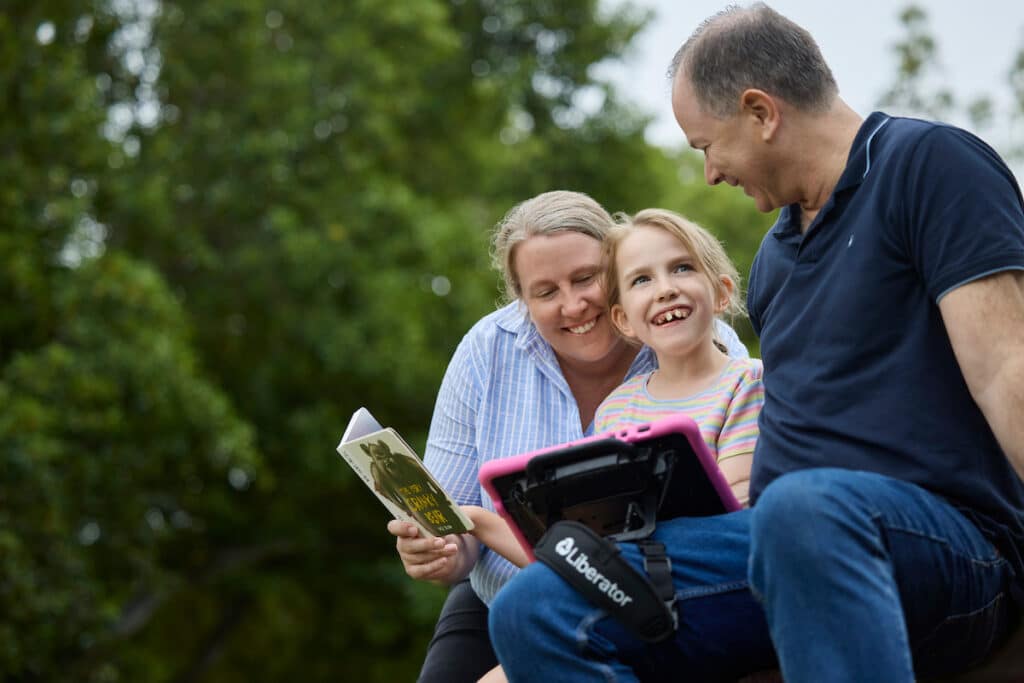
Welcome back to our AAC myth-busting series! In Part 1, we explored timing and early communication. Today, we’re tackling what might be your biggest worry if you’re considering AAC: “But what about speech?”
We get it. This concern comes up in nearly every conversation we have with families and even some fellow professionals. It makes complete sense – you want every possible opportunity for speech development, and the last thing you’d want is to accidentally interfere with that.
Here’s what we can confidently tell you: the research is overwhelmingly clear and reassuring. Let’s dive into what we actually know about AAC and speech development.
Here’s what we’ll look at today (click the myth to jump to the content):
- AAC Myth 1: “Speech just naturally develops in all children – it’s easy!”
- AAC Myth 2: “Using AAC will stop someone from developing speech”
- AAC Myth 3: “AAC system use naturally happens when a system is provided”
- AAC Myth 4: “If someone can speak sometimes, they should only use speech”
The AAC and Speech Connection
AAC Myth 1: “Speech just naturally develops in all children – it’s easy!”
What research shows: Speech is actually one of the most complex motor movements our body executes! It requires precise coordination of over 100 muscles in the respiratory, laryngeal, and articulatory systems.
Speech involves:
- Breath control: Managing airflow from the lungs
- Voice production: Coordinating vocal cord movements
- Articulation: Precise tongue, lip, and jaw positioning
- Motor planning: Sequencing all these movements rapidly and accurately
- Timing: Coordinating everything in milliseconds
The reality: Speech is separate from language. A person may have rich language understanding and complex thoughts but struggle with the motor execution of speech. This is exactly why AAC is so valuable – it provides access to language expression without requiring the complex motor patterns that speech demands.
AAC Myth 2: “Using AAC will stop someone from developing speech”
This is perhaps the most persistent myth about AAC, and understandably, it causes significant worry. The research tells a different story entirely.
What research shows: Consistent exposure to spoken language through AAC devices often supports speech development rather than hindering it.¹
The reality: AAC and speech work together. When people hear consistent spoken models through their AAC device and see language being used meaningfully, it often encourages speech development. Many AAC users develop multimodal communication – using a combination of their device, gestures, signs, and speech as it emerges.
The Power of Modelling
AAC Myth 3: “AAC system use naturally happens when a system is provided”
We understand why there are worries about AAC impacting speech development. We know that any concern comes from a place of love and wanting the best opportunities for your child, friend, family member or client.
The great news is that research consistently shows AAC supports speech in many ways
You can model:
– On a person’s AAC system (with their permission – always respect someone’s communication device as personal)
– On your own AAC system
– On low-tech AAC systems
–Through no-tech modelling e.g. no-tech modelling, including gesture, sign, facial expression, eyegaze, etc.
– On classroom smartboards

Communicating with AAC requires language and system learning. Communication partners can support this learning through modelling. It is an essential strategy that provides rich language input that supports ALL forms of communication.
Modelling, or Aided Language Stimulation (ALS), is an evidence-based strategy that involves pointing to symbols or words on an AAC system while talking with someone. It is essential for all language learning, including AAC!
Research shows that this approach supports AAC communicators to learn language through their AAC system.
Just like learning any language, people need to see and hear AAC being used naturally throughout their day – during greetings, conversations, reading, everyday interactions and routines across all environments.
The reality: Modelling AAC doesn’t hinder AAC use – or speech use. It is an essential strategy that provides rich language input that supports ALL forms of communication.
Embracing Multimodal Communication
AAC Myth 4: “If someone can speak sometimes, they should only use speech”
What research shows: Multimodal communication is both natural AND effective.
AAC users often show improvements in engagement, attention, independence, confidence, participation, academic progress, and social interaction.²
Research and stories from AAC communicators also shows that producing speech can be effortful, tiring, and unreliable at times. In these moments, it is essential they have access to AAC to ensure communication can continue even when speech is not available.
Think about how you communicate throughout your day.
You likely use:
- Spoken words
- Facial expressions
- Gestures
- Writing (texts, emails, notes)
- Pictures (emojis, photos)
This multimodal approach is completely natural!
The reality: Communication naturally occurs through multiple channels. Supporting AAC communicators with a comprehensive communication toolkit allows them to express themselves more effectively across different situations and contexts.
Some people might use their device when they’re tired, speech for quick interactions, or gestures for emphasis. This flexibility is a strength, not a limitation.
Addressing the Fear: Key thoughts on AAC Concerns
We understand why there are worries about AAC impacting speech development. We know that any concern comes from a place of love and wanting the best opportunities for your child, friend, family member or client.
The great news is that research consistently shows AAC supports speech in many ways

Here’s what you can feel confident about:
- AAC won’t prevent speech – it often supports it by providing rich language models
- You’re not “giving up” on speech – you’re providing more pathways for communication
- Pressure often backfires – reducing communication stress through AAC can actually help speech emerge more naturally
- Success builds success – every positive communication experience builds confidence that supports all communication attempts
- No harm in trying – research consistently shows that AAC doesn’t prevent speech development
Remember, whether speech develops or not, your child deserves full access to communication right now. AAC ensures they can participate, learn, connect, and express themselves while other skills develop naturally.
Coming up next…
Part 3 of our series will explore what AAC can achieve beyond ‘the basics,’ including social communication, storytelling, and complex conversations.
Want to experience AAC yourself? Contact our team today about device trials and discover the communication possibilities for your family!
Interested in learning more about AAC? Join one of our upcoming workshops or training events. Check out our full calendar here. You can also find AAC implementation resources at the Centre for AAC & Autism website.
References:
¹ Millar, D. C., Light, J. C., & Schlosser, R. W. (2006). The impact of augmentative and alternative communication intervention on the speech production of individuals with developmental disabilities: a research review. Journal of Speech, Language, and Hearing Research, 49(2), 248-264.
² Abrahamsen, Romski, & Sevcik, 1989. Van Tatenhove, 1987.
